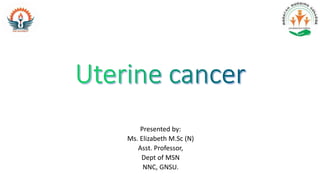
12. Uterine Cancer
- 1. Presented by: Ms. Elizabeth M.Sc (N) Asst. Professor, Dept of MSN NNC, GNSU.
- 2. Uterine Cancer It may refers to any of several different types of cancer which occurs in uterus, namely: • Endometrial cancer – originates from cells in the gland of endometrium • Cervical cancer – arise from transformation zone of the cervix, lower portion of the uterus.
- 3. Risk factors • Increased estrogen • Obesity • Older age • Genetics • Viral infection (HPV)
- 4. Symptoms • Bleeding or watery discharge from vagina • Back Pain • In later stages of the disease, women may feel pelvic pain and experience unexplained weight loss.
- 5. Pathophysiology • Endometrial cancer forms when there are error in normal endometrial cell growth. • Cancer starts when new cells form unneeded and old or damaged cells do not die as they should.
- 6. • These abnormal cancer cells have many genetic abnormalities that cause them to grow excessively.
- 7. Diagnostic Parameters Transvaginal Ultrasound: An ultrasound uses sound waves to create a picture of internal organs. If the endometrium looks too thick, the doctor may decide to perform a biopsy. Hysteroscopy: It allows to do a visual examination of the endometrium of uterus.
- 8. Biopsy: Testing for endometrial cancer or endometrial hyperplasia. CT Scan and MRI: Both are used to measure the tumor’s size. CA 125 Blood Test:
- 9. Treatment Once cancer has been diagnosed, treatment strategy depends on the extent (stage) of your cancer. Stages of endometrial cancer include: • Stage I cancer is found only in uterus. • Stage II cancer is present in both the uterus and cervix. • Stage III cancer has spread beyond the uterus, but hasn't reached the rectum and bladder. The pelvic area lymph nodes may be involved. • Stage IV cancer has spread past the pelvic region and can affect the bladder, rectum and more-distant parts of your body.
- 10. Surgery • Hysterectomy: Removal of uterus • Lymph node dissection: Removal of lymph nodes near the tumor if the cancer has spread beyond the uterus.
- 11. Radiation Therapy The radiation therapy is most often given after surgery to destroy any cancer cells remaining in the area but rarely given before surgery to shrink the tumor.
- 12. Hormone Therapy • Hormone therapy for uterine cancer often involves the hormone progesterone, given in a pill form. • An AI is a drug that reduces the amount of the hormone estrogen in a woman's body by stopping tissues and organs other than the ovaries from producing it with other types of treatment.
- 13. Hormone therapy may also be used for women who cannot have surgery or radiation therapy or in combination.
- 14. Chemotherapy • The chemo often includes the combination of Doxorubicin+ Cisplatin+ Paclitaxel. • Pazopanib blocks angiogenesis and stop the growth of cancer cell.
- 15. Vaccination • The World Health Organization (WHO), as well as public health officials in Australia, Canada, Europe, and the United States recommend this vaccination against HPV. • Both vaccines protect against the two HPV types (HPV-16 and HPV- 18) that cause 70% of cervical cancers.
- 16. • Both vaccines are given as a series of three injections over a six- month period. • The second dose is given one to two months after the first dose, and the third dose is given six months after the first dose
- 17. Nursing Management • Monitor for adverse effects of radiation therapy such as fatigue, sore throat, dry cough, nausea, anorexia. • Monitor for adverse effects of chemotherapy; bone marrow suppression, nausea and vomiting, alopecia, weight gain or loss, fatigue, stomatitis, anxiety, and depression. • Realize that a diagnosis of breast cancer is a devastating emotional shock to the woman. Provide psychological support to the patient throughout the diagnostic and treatment process. • Involve the patient in planning and treatment. • Describe surgical procedures to alleviate fear.
- 18. Nursing Management • Prepare the patient for the effects of chemotherapy, and plan ahead for alopecia, fatigue. • Administer antiemetics prophylactically, as directed, for patients receiving chemotherapy. • Administer I.V. fluids and hyperalimentation as indicated. • Help patient identify and use support persons or family or community. • Suggest to the patient the psychological interventions may be necessary for anxiety, depression, or sexual problems. • Teach all women the recommended cancer-screening procedures